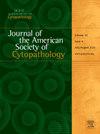Diagnostic performance of the hologic genius digital diagnostics system for low-grade squamous intraepithelial lesion (LSIL) ThinPrep papanicolaou tests
Q2 Medicine
Journal of the American Society of Cytopathology
Pub Date : 2025-01-17
DOI:10.1016/j.jasc.2025.01.003
引用次数: 0
Abstract
Introduction
Advancements in digital imaging technology for Papanicolaou test slides, combined with artificial intelligence are driving the development and adoption of innovative computer-assisted screening methods for cervical cancer within the cytology community. Our study aimed to assess the performance of the Hologic Genius Digital Diagnostic System (HGDDS) in the interpretation of low-grade squamous intraepithelial lesions (LSIL) in ThinPrep Papanicolaou slides.
Materials and methods
As part of a validation study performed with 890 ThinPrep Papanicolaou slides using the HGDDS, a subset of 146 LSIL cases were included in this study. Performance characteristics for the detection of cervical intraepithelial neoplasia (CIN) and interobserver variability among 3 cytopathologists were assessed.
Results
On evaluation of the consensus results of the 3 cytopathologists, of the 146 LSIL Papanicolaou cases, 60.3% were interpreted as LSIL with the HGDDS. The remainder were interpreted as ASCUS (26%), ASC-H (10.3%), HSIL (2.7%), and NILM (0.7%). The sensitivity, specificity, positive predictive value (PPV) and negative predictive value (NPV) for detecting CIN1+ lesions in the ASCUS + category with the HGDDS were 100%, 25%, 97.9%, and 100%, respectively. The sensitivity, specificity, PPV, and NPV for the detection of CIN1+ lesions in the LSIL + category with the HGDDS were 74.7%, 75%, 99.1%, and 7.7%, respectively. Kendall’s W coefficient was 0.792, indicating strong agreement among participating pathologists.
Conclusions
Our study demonstrated that ThinPrep Papanicolaou tests with LSIL could be interpreted with strong agreement among pathologists and with good performance indicators when utilizing the HGDDS.
hologic genius数字诊断系统对低级别鳞状上皮内病变(LSIL)的诊断性能
引言:Papanicolaou玻片数字成像技术的进步,结合人工智能,正在推动细胞学领域创新的宫颈癌计算机辅助筛查方法的发展和采用。我们的研究旨在评估Hologic Genius数字诊断系统(HGDDS)在ThinPrep Papanicolaou玻片中解释低级别鳞状上皮内病变(LSIL)的性能。方法:作为使用HGDDS对890例ThinPrep Papanicolaou载玻片进行验证研究的一部分,本研究包括146例LSIL病例。评估了3名细胞病理学家检测宫颈上皮内瘤变(CIN)的表现特征和观察者之间的变异性。结果:经3名细胞病理学家的一致评价,146例LSIL Papanicolaou病例中,60.3%被解释为LSIL伴HGDDS。其余解释为ASCUS(26%)、ASC-H(10.3%)、HSIL(2.7%)和NILM(0.7%)。HGDDS检测ASCUS +类CIN1+病变的敏感性、特异性、阳性预测值(PPV)和阴性预测值(NPV)分别为100%、25%、97.9%和100%。HGDDS检测LSIL +类CIN1+病变的敏感性、特异性、PPV和NPV分别为74.7%、75%、99.1%和7.7%。Kendall的W系数为0.792,表明参与的病理医师之间的一致性很强。结论:我们的研究表明,当使用HGDDS时,使用LSIL的ThinPrep Papanicolaou检测在病理学家之间具有很强的一致性,并且具有良好的性能指标。
本文章由计算机程序翻译,如有差异,请以英文原文为准。
求助全文
约1分钟内获得全文
求助全文
来源期刊

Journal of the American Society of Cytopathology
Medicine-Pathology and Forensic Medicine
CiteScore
4.30
自引率
0.00%
发文量
226
审稿时长
40 days
 求助内容:
求助内容: 应助结果提醒方式:
应助结果提醒方式:


